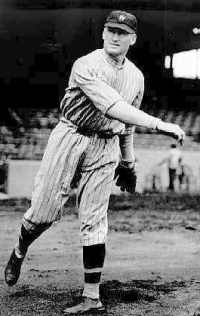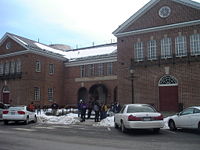Difference between revisions of "Walter Johnson" - New World Encyclopedia
(New page: {{Started}} {{Infobox baseball player | name=Walter Johnson | image name=Walter_Johnson.jpg | birthdate= November 6, 1887 | birthplace= Humboldt, KS | dea...) |
({{Contracted}}) |
||
| Line 1: | Line 1: | ||
| − | {{Started}} | + | {{Started}}{{Contracted}} |
{{Infobox baseball player | name=Walter Johnson | image name=Walter_Johnson.jpg | {{Infobox baseball player | name=Walter Johnson | image name=Walter_Johnson.jpg | ||
Revision as of 17:04, 4 June 2007

{{{image caption}}}
| |
| Personal Info | |
|---|---|
| Birth | November 6, 1887, Humboldt, KS |
| Death: | December 10 1946, Washington, D.C. |
| Professional Career | |
| Debut | August 2 1907, Washington Nationals |
| Team(s) | Washington Nationals/Senators (1907-1927) |
| HOF induction: | 1936 |
| Career Highlights | |
| |

| |
| Walter Perry Johnson | |
| "The Big Train" | |
| Inducted as a member of the Washington Nationals/Senators (None) | |
| Year Inducted: 1936 | |
| First Year Elligible: 1936 | |
Walter Perry Johnson (November 6, 1887 – December 10, 1946), nicknamed "The Big Train", was an American right-handed pitcher in Major League Baseball between 1907 and 1927. One of the most celebrated players in baseball history, he attained legendary status with his record achievements which remained unbroken for more than a half-century.
Early life
Walter Johnson was born the second of six children to Swedish emigrant parents on a rural farm four miles west of Humboldt, Kansas.[1] Before he reached his fourteenth birthday in 1901, his family moved to California's Orange County, where he attended Fullerton High School. In July 1907, while he was working for the local telephone company and pitching for Weiser, Idaho in the semi-pro Idaho State League, Johnson was spotted by a talent scout and, at the age of nineteen, signed a contract with the Washington Nationals (later Washington Senators, now Minnesota Twins).
Baseball career
Johnson won renown as the premier power pitcher of his era. Although a lack of precision instruments prevented accurate measurement of his fastball, Johnson may well have thrown over 100 miles per hour from a sidearm angle. This power is exceptional even today, but it was virtually unique in Johnson's day.
The overpowering fastball was the primary reason for Johnson's exceptional statistics, especially his fabled strikeout totals. Johnson's record total of 3,509 strikeouts stood for more than 55 years until Nolan Ryan, Steve Carlton, and Gaylord Perry (in that order) all surpassed it in 1983. Johnson is now 9th on the all-time strikeout list, but his total must be understood in its proper context. Among his pre-World War II contemporaries, only two men were within a thousand strikeouts of Johnson: runner-up Cy Young with 2,803 (more than 800 behind) and Tim Keefe at 2,562. Bob Feller, whose war-shortened career began in 1936, later ended up with 2,581.
As a right-handed pitcher for the Washington Nationals/Senators, Walter Johnson won 417 games, the second most by any pitcher in history (after Cy Young, who won 511). He and Young are the only pitchers to have won 400 games or more.
In a 21-year career, Johnson had twelve 20-win seasons, including ten in a row. Twice he topped thirty wins (33 in 1912 and 36 in 1913). Johnson's record includes 110 shutouts, the most in baseball history. Johnson had a 38-26 record in games decided by a 1-0 score; both his win total and his losses in these games are major league records. On September 4, 5 and 7, 1908, he shut out the New York Yankees in three consecutive games.
He thrice won the triple crown for pitchers (1913, 1918 and 1924). Johnson twice won the American League Most Valuable Player Award (1913, 1924). This feat has been accomplished by only two other pitchers, Carl Hubbell in 1933 and 1936 and Hal Newhouser in 1944 and 1945. His earned run average of 1.14 in 1913 was one of the lowest of all time, and indeed held the post-1901 record (not counting Mordecai "Three Finger" Brown), though only for a year, as Dutch Leonard would break the record the next year.
That 1.14 ERA in 1913 should have been lower if not for one of manager Clark Griffith's traditions. For the last game of the season, Griffith often treated the fans to a farce game. Johnson actually played center field that game until he was brought into pitch. He allowed two hits before he was taken out of the game. The next pitcher - who was actually a career catcher - allowed both runners to score. Some record books still indicate that Johnson had a 1.09 ERA for 1913. The official scorekeeper ignored the game, but later, Johnson was charged with those two runs, raising his ERA.
Although he usually pitched for losing teams during his career, Johnson led the Washington Nationals/Senators to two World Series, a victory in 1924 (including the final, 12-inning game) and a loss in 1925.
Johnson was a better-than-average hitter for a pitcher, compiling a career batting average of .235, including a record .433 average in 1925. He also made 13 appearances in the outfield during his career. He hit over .200 in 13 of his 21 seasons as a hitter, and actually hit 12 doubles and a triple in 130 at bats in 1917. In a season where Johnson had 28 wins, he also had more home runs than Ty Cobb, Honus Wagner or Napoleon Lajoie all Hall of Fame hitters.
In 1928, he began his career as a manager in the minor leagues, taking up residence at 32 Maple Terrace, Millburn, New Jersey, and managing the Newark team of the International League. He continued on to the major leagues, managing the Washington Nationals/Senators (1929-1932), and finally the Cleveland Indians (1933-1935). Johnson also served as a radio announcer for the Senators during the 1939 season.
One of the first five players elected to the Baseball Hall of Fame in 1936, Walter Johnson retired to Germantown, Maryland and was elected Montgomery County commissioner in 1938. In 1940 he received the Republican nomination for U.S. Congress from Maryland's 6th congressional district, subsequently losing to Democrat William D. Byron by a 60,037 to 52,258 vote margin.
In the remaining six years of his life, Walter Johnson gave his full efforts to patriotic public appearances at war bond rallies. He died of a brain tumor in Washington, D.C., five weeks after his 59th birthday, and was interred in Rockville, Maryland's Rockville Union Cemetery.
Additional facts and details
Walter Johnson High School in Bethesda, Maryland has been named for him. The monument to him that once stood outside Griffith Stadium has been moved to the school's campus.
He was also called "Sir Walter" and "the White Knight" because of his gentlemanly gamesmanship, and "Old Barney" later in his career. In 1985, the rock musician Jonathan Richman recorded a song entitled "Walter Johnson" that celebrated Johnson's kindness.
In 1999, he ranked number 4 on The Sporting News' list of the 100 Greatest Baseball Players, the highest-ranked pitcher. Later that year, he was elected to the Major League Baseball All-Century Team.
Johnson's gentle nature was legendary, and to this day he is held up as an example of good sportsmanship while his name has become synonymous with friendly competition. This attribute worked to Johnson's disadvantage in the case of fellow Hall of Famer Ty Cobb. Virtually all batters were concerned about being hit by Johnson's fastball, and many would not "dig in" at the plate because of that concern. Cobb realized that the good-hearted Johnson was privately nervous about the possibility of seriously injuring a batsman. Almost alone among his peers, Cobb would actually stand closer to the plate than usual when facing Johnson.
Johnson's rookie season was Cobb's third, and Johnson retired one year before Cobb. Cobb faced Johnson at bat more times in their overlapping careers than any other hitter-pitcher combination in major league history.
Johnson was immortalized in the poem "Lineup for Yesterday, by Ogden Nash, thus:
J is for Johnson.
The Big Train in his prime,
So fast he could throw
Three strikes at a time.
Statistics
Career Statistics:
Hitting
| G | AB | H | 2B | 3B | HR | R | RBI | BB | SO | AVG | OBP | SLG | OPS |
| 933 | 2,324 | 547 | 94 | 41 | 24 | 241 | 255 | 110 | 251 | .235 | .266 | .342 | 0.608 |
Pitching
| W | L | WP | GP | GS | CG | Sh | SV | IP | BB | SO | ERA | WHIP |
| 417 | 279 | .599 | 802 | 666 | 531 | 110 | 34 | 5,914.1 | 1,363 | 3,509 | 2.17 | 1.06 |
Reference
Thomas, Henry W. (1995). Walter Johnson: Baseball's Big Train. Washington, D.C.: Phenom Press. ISBN 0964543907
External links
- Baseball Hall of Fame
- Baseball-Reference.com - Major league career statistics
- Baseball Almanac
- BaseballLibrary
- Find-A-Grave
- Homage to Johnson
- a preserved recording of Walter Johnson announcing the radio play-by-play for the Washington Senators vs. Cleveland Indians game on September 21, 1939
- Walter Johnson at the Internet Movie Database
| Preceded by: Vean Gregg |
American League ERA Champion 1912-1913 |
Succeeded by: Dutch Leonard |
| Preceded by: Rube Waddell |
American League Pitching Triple Crown 1913, 1918 & 1924 |
Succeeded by: Lefty Grove |
| Preceded by: Tris Speaker |
American League Most Valuable Player 1913 |
Succeeded by: Eddie Collins |
| Preceded by: Eddie Cicotte |
American League ERA Champion 1918-1919 |
Succeeded by: Bob Shawkey |
| Preceded by: Stan Coveleski |
American League ERA Champion 1924 |
Succeeded by: Stan Coveleski |
| Preceded by: Babe Ruth |
American League Most Valuable Player 1924 |
Succeeded by: Roger Peckinpaugh |
| Preceded by: Bucky Harris |
Washington Nationals/Senators Manager 1929-1932 |
Succeeded by: Joe Cronin |
| Preceded by: Roger Peckinpaugh |
Cleveland Indians Manager 1933-1935 |
Succeeded by: Steve O'Neill |
| |||||||||||
| |||||
Template:3000 strikeout club
Credits
New World Encyclopedia writers and editors rewrote and completed the Wikipedia article in accordance with New World Encyclopedia standards. This article abides by terms of the Creative Commons CC-by-sa 3.0 License (CC-by-sa), which may be used and disseminated with proper attribution. Credit is due under the terms of this license that can reference both the New World Encyclopedia contributors and the selfless volunteer contributors of the Wikimedia Foundation. To cite this article click here for a list of acceptable citing formats.The history of earlier contributions by wikipedians is accessible to researchers here:
The history of this article since it was imported to New World Encyclopedia:
Note: Some restrictions may apply to use of individual images which are separately licensed.